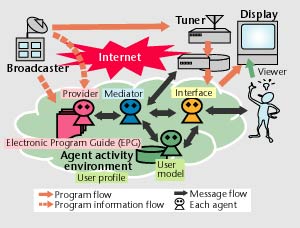|
Japanese Digital Satellite Broadcasting
System Approved As International Standard
The digital satellite broadcasting system (ISDB-S) which Japan had proposed
was approved as a Recommendation by ITU-R vote.
An ITU-R (International Telecommunication Union-Radiocommunication Sector)
meeting regarding broadcasting related issues was held May 31 through
June 2, 1999 in Geneva, Switzerland. On this occasion, the system that
had been proposed by Japan was adopted as a draft Recommendation, in
addition to the already-recommended European and U.S. systems. The approval
procedure by vote was conducted until its due day of October 7, and
the system was approved as a Recommendation on October 13.
The main advantages of the digital BS broadcasting system that Japan
had proposed are;
- The adoption of TC8PSK that can transmit two HDTV programs.
- The mechanism that permits continuous broadcasting even with weaker
signals caused by heavy rains.(hierarchical transmission)
Digital BS broadcasting will start in December, 2000 using this system.
Japanese Digital Terrestrial Television
Broadcasting System Adopted at ITU-R
At ITU-R held February 2000, the digital terrestrial television broadcasting
system (ISDB-T) proposed by Japan was adopted as one of the draft Recommendations.
The Japanese system (ISDB-T) was adopted in addition to the European
(DVB-T) and the U.S. system (DTV) which had already been approved as
digital terrestrial television broadcasting systems.
Although all of the three recommended systems are able to broadcast
approximately one HDTV or about three SDTV programs for fixed reception,
the Japanese system features: 1) good mobile reception which can be
maintained even under severe transmission conditions and 2) flexible
use for fixed reception and portable/mobile reception in one channel.
The conducting of a vote for the final approval is scheduled, with the
draft Recommendation requiring more than 70% of the total votes in its
favor to receive approval.
Agent-TV Development by FACTS
TV with automatic customized program selection for
viewers
The multi-channel, multimedia era will make massive amounts of information
accessible to viewers via digital broadcasting such as ISDB or other
interactive networks. To deal successfully with the new media age, advent
of intelligent, functional TV sets called "agent-TV" are expected. Such
TV sets can select and present programs of personal interest to viewers.
These TV sets store in their receivers information regarding viewers'
individual preferences and profiles as well as indexed information such
as live broadcast programs. This will enable an agent-TV to select and
display programs according to an individual viewer's interests.
 The FACTS (FIPA Agent Communication Technologies and Services) project
was established to validate and to propose modification of standard
specification by implementing actual systems based on international
agent technology specification. FACTS is a two year project which started
in March of 1998 and will continue until February of 2000. CSELT (Italy),
The Imperial College (UK), IRST (Italy), and NHK have participated and
promoted research and development for the project. As a result and a
first in the broadcasting field, an agent application that complies
with the international standard was implemented.
The FACTS (FIPA Agent Communication Technologies and Services) project
was established to validate and to propose modification of standard
specification by implementing actual systems based on international
agent technology specification. FACTS is a two year project which started
in March of 1998 and will continue until February of 2000. CSELT (Italy),
The Imperial College (UK), IRST (Italy), and NHK have participated and
promoted research and development for the project. As a result and a
first in the broadcasting field, an agent application that complies
with the international standard was implemented.
|





